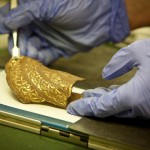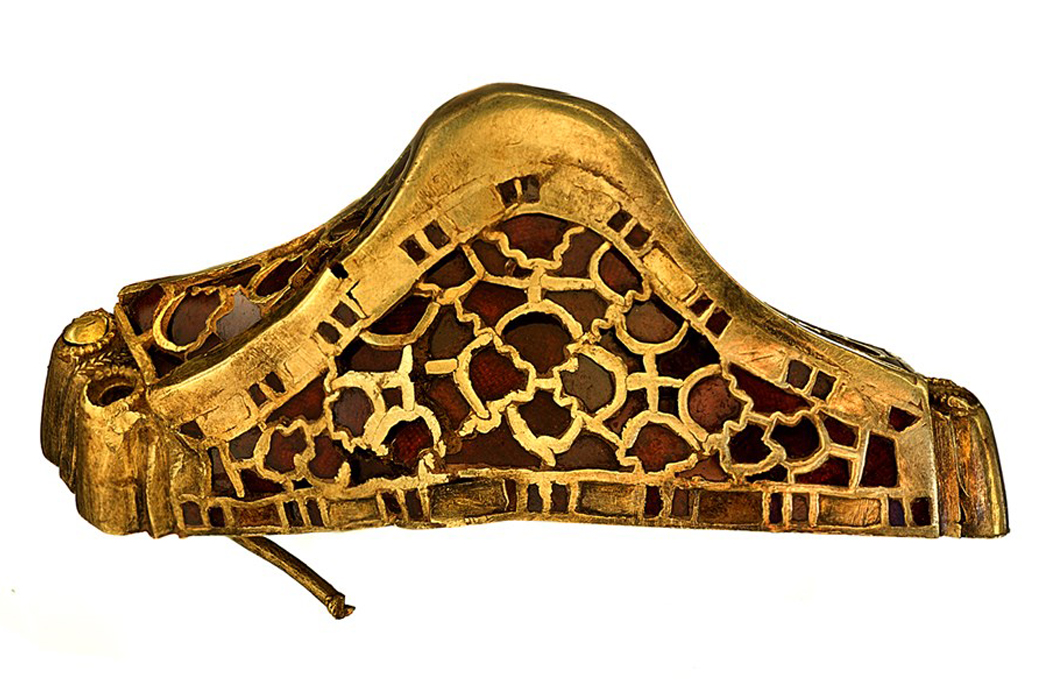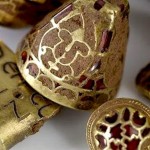Apart from the information concerning the upcoming final publication the December issue of the newsletter from the team behind the Staffordshire Hoard tells us about the helmet crest, the organic filling beneath the cloisonné and inside pommel caps and much more
Helmet Crest
Currently a project is underway consisting a reconstruction of the second and very fragmented helmet crest. With 25 distorted fragments the assemblage is really tricky as the reconstruction of its natural curve has to come before the construction of the mount which can be used in the exhibition. The plan is of course to use the information in order to reconstruct a model of the helmet. What did it look like? We are all eagerly awaiting the answer to this question. Another item, which has been painstakingly assembled from 12 individual fragments, is a hilt collar.
The Organics
Not often considered the hoard also exhibits small fragments of wood, bone and horn, all identified as structural and decorative components of some of the items in the hoard. To this should be added the remnants of the bedding materials used in the production of garnet cloissoné or as filler in several pommel caps. This material has consisted of mixtures of beeswax and animal glue. Another intriguing component is the residue from lime processing found inside pommel caps. Was lime burning widely practised at this point?
The Metal
During the last months a pilot-study of the surface some of the silver hilt-plates and cheek have been going on, demonstrating the fact that they were originally gilded. Another intriguing fact is the composition of the alloy which hint that the pieces might have been made from recycled gilded silver. It has also become apparent that the goldsmith recognized the quality and purity of different pieces of silver, using the purer alloys whenever more spectacular pieces were being made.
Pommel Art
The hoard numbers over 70 pommels, which considered together demonstrate the full range of what fine metalworkers were able to achieve in the 6th and 7th centuries. A comprehensive survey has demonstrated that no two pommels are exactly alike. But it also demonstrates a particular preference for Animal Art (style 2) and paired creatures with biting jaws. This design can be traced back to the 5th and 6th centuries when it dominated in Northwestern Europe. The curators are speculating that the use of the motif in 7th-century England could indicate a ‘pagan’ legacy remembered in a period otherwise characterised by religious conversion.
An Equestrian Warrior
Tantalizing pieces are the die-impressed sheets, which derive from at least one magnificent helmet. Whilst many body-parts are still missing it has now been confirmed by the team that the mounted warrior shown in one of these pieces wore a helmet with distinctive in-curved cheek-guards, comparable to certain Roman cavalry helmets. Particularly intriguing is the presence of an extra “Shield Boss” in the mixture of the tableau. Is it part of the fitting of the horse or is it rather a piece of decoration similar to which may be found in the Swedish material from the boat-graves in Valsgärde?
Recent publications from the Project
The assembly of the Staffordshire Hoard objects
By R. Allpeter, C. Fern, K. Fuller, K., P. Greaves, P. and L. Miller
News in Conservation October 2015, 7-10.
Never judge a gold object by its surface analysis: a study of surface phenomena in a selection of gold objects from the Staffordshire Hoard
By E. S. Blakelock,
In: Archaeometry . 2015
SOURCE:
FEATURED PHOTO:
Staffordshire pommel with lime mortar in its core © Staffordshire Hoard
READ ALSO:
 Staffordshire Hoard reveals yet another helmet and a rare pommel
Staffordshire Hoard reveals yet another helmet and a rare pommel

 Staffordshire Hoard Gallery
Staffordshire Hoard Gallery Staffordshire Hoard – Status 2014
Staffordshire Hoard – Status 2014